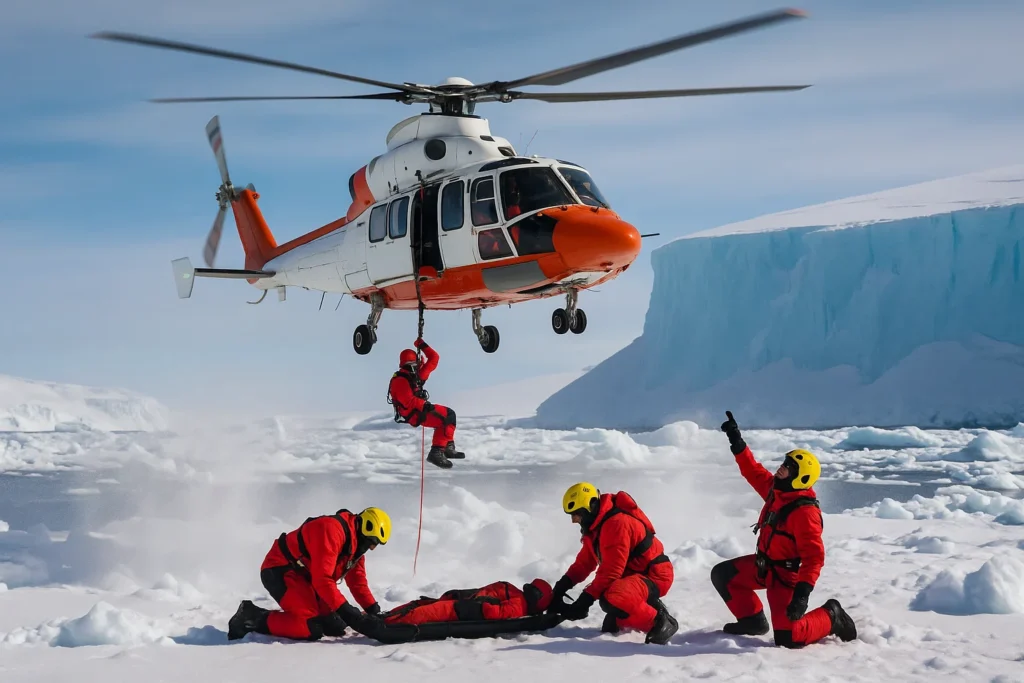✨ Introduction: Helicopter Rescues in the Extreme Cold
Helicopter Rescue Missions in Antarctica : Antarctica, the coldest, driest, and windiest continent on Earth, presents some of the most challenging environments for human survival. Despite the extreme conditions, scientific research, expeditions, and tourism continue in the region. However, accidents and emergencies are inevitable, and in these harsh conditions, helicopter rescue missions are often the only way to save lives. These missions require specialized equipment, highly skilled pilots, and advanced planning to overcome the unique challenges posed by the Antarctic landscape.
🛫 Why Helicopter Rescues Are Essential in Antarctica
🏔️ Accessing Remote Areas
The vast and rugged terrain of Antarctica makes it extremely difficult to access many areas by land or sea. Helicopters, however, are able to reach remote research stations, field camps, or accident sites where traditional vehicles cannot go. Whether it’s rescuing researchers or tourists in distress, helicopters offer the fastest and most effective way to reach those in need.
❄️ Extreme Weather Conditions
The unpredictable and severe weather in Antarctica can change rapidly. Blizzards, whiteouts, and high winds are common, which can prevent ground vehicles from traveling. Helicopters, designed for such challenging conditions, are crucial for navigating through these weather systems and providing timely assistance when required.
🚁 Time-Sensitive Missions
In emergency situations, every minute counts. Whether it’s a medical evacuation or a rescue operation following an accident, helicopter rescue missions allow for quick response times, ensuring that help arrives as quickly as possible. The ability to get to the site fast can be a matter of life and death, especially when temperatures can plummet to life-threatening levels.
🏰 Types of Helicopter Rescue Missions in Antarctica
🩺 Medical Evacuations
Medical emergencies in Antarctica, such as severe injuries, illnesses, or accidents, require fast intervention. Helicopter rescue teams are equipped to transport patients to specialized medical facilities, such as the McMurdo Station or other nearby stations, where they can receive advanced treatment. The helicopters are typically equipped with medical kits, stretchers, and trained personnel to stabilize patients during transit.
🏔️ Search and Rescue (SAR) Missions
Antarctica’s extreme conditions make it easy for explorers, researchers, or tourists to become lost, disoriented, or stranded. In such situations, helicopter search and rescue teams are deployed to find missing persons and bring them to safety. These missions are challenging because of the vast, ice-covered landscape, low visibility, and constant risk of bad weather.
🚨 Tourist Evacuations
With an increasing number of tourists visiting Antarctica, evacuation operations for injured or sick tourists are also common. Helicopters offer a swift way to transport tourists to safety, whether they’re at a research station or a remote area of the continent.
🛬 How Helicopters Operate in Antarctica’s Extreme Environment
🏔️ Adapted Helicopter Technology
Helicopters used in Antarctic rescue missions are specifically adapted to handle extreme cold temperatures and harsh conditions. These helicopters are equipped with specialized heating systems, de-icing technology, and weather-resistant materials that ensure their functionality in sub-zero temperatures. Models like the Bell 212 and Sikorsky S-92 are commonly used due to their reliability in harsh environments.
🌬️ Navigating Harsh Winds and Weather
The ability of helicopters to withstand high winds, low visibility, and snowstorms is vital for their effectiveness in Antarctica. Helicopters are equipped with advanced avionics that help pilots navigate through snowstorms and cloudy conditions. The pilots themselves are trained to operate under low-visibility conditions, ensuring that rescues can be conducted safely and efficiently.
🏔️ Specialized Pilots and Rescue Teams
Pilots and rescue teams working in Antarctica undergo extensive training to handle the unique challenges of the region. They are skilled in navigating through extreme weather conditions and are well-versed in operating in high-altitude environments. The rescue teams also include paramedics, doctors, and support personnel who are trained to provide first aid and care during the evacuation process.
🚁 Challenges of Helicopter Rescue Missions in Antarctica
🧊 Icy and Rugged Terrain
The icy landscape and towering glaciers of Antarctica present a challenge for helicopter landings and operations. While helicopters can hover above the ground, finding suitable landing zones in the icy terrain is often difficult. Rescue missions require careful planning to locate safe and accessible landing sites near the incident location.
❄️ Fuel and Equipment Limitations
In Antarctica, access to fuel and spare parts for helicopters can be limited. This requires careful logistical planning to ensure that helicopters are fueled and equipped for long-distance flights. Fuel shortages, combined with extreme temperatures, can limit the duration of rescue missions, making quick action crucial.
🌍 Environmental Considerations
Environmental concerns play a significant role in helicopter operations in Antarctica. The ecosystem is highly sensitive, and all operations must minimize the environmental impact. Rescue teams must ensure that their operations do not disrupt wildlife or pollute the pristine environment, adding an additional layer of complexity to the mission.
🚁 Why Choose DreamSafar for Antarctic Helicopter Missions?
🌟 Experienced Pilots and Equipment
DreamSafar is equipped with top-tier helicopters and experienced pilots trained to handle even the most extreme environments. We ensure that all our rescue missions are carried out with the highest standards of safety and efficiency.
🛫 Fast Response Time
We understand the importance of quick action during rescue missions, and our team is committed to responding swiftly to emergencies. Whether it’s a medical evacuation or a search and rescue mission, DreamSafar ensures that help is on the way as soon as possible.
🌍 Global Reach and Expertise
With our experience in providing air services across remote and extreme locations, DreamSafar is well-equipped to handle Antarctic helicopter missions with the highest level of expertise. Our helicopters are equipped to fly in the harshest of conditions, ensuring that our operations are always carried out safely and efficiently.
🔗 Useful Links:
Resources:
❓ FAQ Section:
Q1: How do helicopters operate in Antarctica’s extreme weather conditions?
A1: Helicopters in Antarctica are specially equipped with de-icing technology, heating systems, and weather-resistant materials to withstand sub-zero temperatures and harsh winds, allowing them to operate in extreme conditions.
Q2: What type of missions do helicopters carry out in Antarctica?
A2: Helicopter missions in Antarctica typically involve medical evacuations, search and rescue operations, and tourist evacuations, especially in remote locations or during extreme weather events.
Q3: How long do helicopter rescue missions take in Antarctica?
A3: The duration of helicopter rescue missions depends on the location and weather conditions. Typically, helicopter rides can last between 15 to 30 minutes, but more complex rescues may require longer flights, especially in remote areas.


